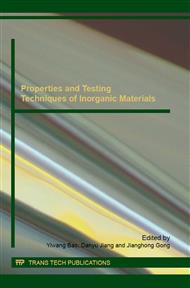[1]
Rusu GG, Rambu AP, Buta VE, et al., Strutural and optical characterization of Al-doped ZnO films prepared by thermal oxidation of evaporated Zn/Al multi-layered films, Mater Chem Phys. 123 (2010) 314–321.
DOI: 10.1016/j.matchemphys.2010.04.022
Google Scholar
[2]
Kang HS, Kang JS, Pang SS, et al., Variation of light emitting properties of ZnO thin films depending on post-annealing temperature, Mater Sci Eng B. 102 (2003) 313–316.
DOI: 10.1016/s0921-5107(02)00730-4
Google Scholar
[3]
Fu YQ, Luo XY, Flewitt AJ, et al., Recent developments on ZnO films for acoustic wave based bio-sensing and microfluidic applications: a review, Sens Actuators B. 143 (2010) 606–619.
DOI: 10.1016/j.snb.2009.10.010
Google Scholar
[4]
Lee JB, Lee HJ, Seo SH, Park JS, Characterization of undoped and Cu-doped ZnO films for surface acoustic wave applications, Thin Solid Films. 398 (2001) 641–646.
DOI: 10.1016/s0040-6090(01)01332-3
Google Scholar
[5]
Li Z. W, Gao W, ZnO thin films with DC and RF reactive sputtering, Mater Lett. 58 (2004) 1363–1370.
DOI: 10.1016/j.matlet.2003.09.028
Google Scholar
[6]
Singh P, Kaushal A, Kaur D, Mn-doped ZnO nanocrystal-line thin films prepared by ultrasonic spray pyrolysis., J Alloys Compd. 471 (2009) 11–15.
DOI: 10.1016/j.jallcom.2008.03.123
Google Scholar
[7]
A. Kominami, H. Tatsuoka, H. Luminescent, properties of ZnO thin films grown epitaxially on Si substrate, Crystal Growth. 214 (2000) 294–298.
DOI: 10.1016/s0022-0248(00)00095-6
Google Scholar
[8]
Zeng YJ, Ye ZZ, Xu WZ, Liu B, Che Y, Zhu LP, Zhao BH, Study on the Hall-effect and photoluminescence of N-doped p-type ZnO thin films, Mater Lett. 61 (2007) 41–44.
DOI: 10.1016/j.matlet.2006.04.001
Google Scholar
[9]
Xu LH, Shi LX, Li XY, Effect of TiO2 buffer layer on the structure and optical properties of ZnO thin films deposited by E-beam evaporation and sol–gel method, Appl Surf Sci. 255 (2008) 3230–3234.
DOI: 10.1016/j.apsusc.2008.09.026
Google Scholar
[10]
Lamia Znaidi, Sol–gel-deposited ZnO thin films: A review. Materials Science and Engineering B. 174 (2010) 18–30.
DOI: 10.1016/j.mseb.2010.07.001
Google Scholar
[11]
M.H. Habibi, M. Khaledi Sardashti, Structure and Morphology of Nanostructured Zinc Oxide Thin Films Prepared by Dip-vs. Spin-Coating Methods, J. Iran. Chem. 04 (2008) 603-609.
DOI: 10.1007/bf03246140
Google Scholar
[12]
Yidong Zhang, Wenjun Fa, Fengling Yang, Effect of annealing temperature on the structural and optical properties of ZnO thin films prepared by sol–gel method, Springer. 16 (2010) 815–820.
DOI: 10.1007/s11581-010-0468-4
Google Scholar
[13]
Z. R. Khan, M. Zulfequar, M. S. Khan, Optical and Structural Properties of Thermally Evaporated Cadmium Sulphide Thin Films on Silicon (100) Wafers, Mater. Sci. Eng. B. 174 (2010) 145-149.
DOI: 10.1016/j.mseb.2010.03.006
Google Scholar
[14]
M. Ohyama, H. Kozuka, T. Yoko, Sol-Gel Preparation of ZnO Films with Extremely Preferred Orientation along (002) Plane from Zinc Acetate Solution, Thin Solid Films. 306 (1997) 78-85.
DOI: 10.1016/s0040-6090(97)00231-9
Google Scholar
[15]
Shen Wenjuan, Wang Jun, Duan Yao, Effects of Thickness on Properties of ZnO Films Grown on Si by MOCVD, Chinese Journal of Semiconductors. 26 (2005) 2070-(2071).
Google Scholar
[16]
M. Smirnov, C. Baban, G.I. Rusu, Structural and optical characteristics of spin-coated ZnO thin films, Appl. Surf. Sci. 256 (2009) 2405.
DOI: 10.1016/j.apsusc.2009.10.075
Google Scholar
[17]
M. H. Huang, S. Mao, H. Feick, H. Yan, Y. Wu, H. Kind, E. Weber, R. Russo and P. Yang, Room-Temperature Ultraviolet Nanowire Nanolasers, Science. 292 (2001) 1897-1899.
DOI: 10.1126/science.1060367
Google Scholar
[18]
Shinde VR, Lokhande CD, Mane RS, Han SH, Hydrophobic and textured ZnO films deposited by chemical bath deposition: annealing effect, Appl Surf Sci. 245 (2005) 407–413.
DOI: 10.1016/j.apsusc.2004.10.036
Google Scholar


